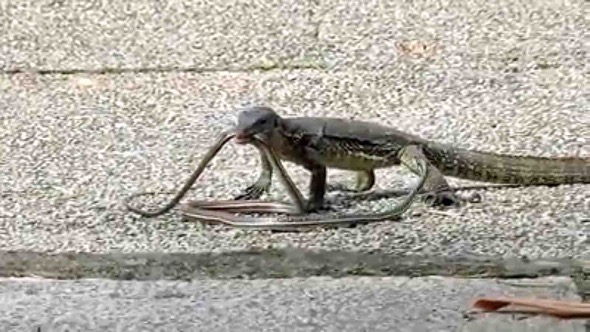Kumchun Chan’s five video clips show how a Malayan Water Monitor (Varanus salvator) struggled to overcome a long snake.
Had the monitor lizard got hold of the snake’s head in the first instance, it would be easy to dispose of its prey. Apparently it was not necessary to aim at the head, if at all it was possible to do so.
So the first bite was at a point somewhere near the tail. But this allowed the snake to target the lizard’s head and belly, possibly the weakest areas as the body is covered with thick scales.
As soon as the snake poised to strike at the lizard’s head, the latter vigorously shook its head. This sent the snake’s head thrashing backwards, even coiling round the lizard’s body. The lizard acted similarly when the snake struck at its belly.
With its jaws clamped on the snake’s body, the lizard was slowly moving towards the head, chomping on the body all the time. At the same time the lizard was rubbing the snake’s body against the hard ground.
The lizard’s jaws finally moved towards the head of the snake at which time the snake lost the will to fight back. Then suddenly the lizard reached out for the tail end and continued chomping on the body.
According to Kumchun, the snake was exhausted within 10 minutes of the struggle. Towards the end the lizard dragged the snake into the nearby bushes as a few people moved closer. Most probably the lizard eventually swallowed the snake.
Kumchun Chan
Singapore
3rd March 2017
This post is a cooperative effort between Birds, Insects N Creatures Of Asia and BESG to bring the study of birds and their behavior through photography and videography to a wider audience.










2 Responses
Interesting video of a very small monitor lizard trying to eat a very large Bronzeback snake, probably a Painted Bronzeback, (Dendrelaphis pictus). I say “probably” because the taxonomy of Bronzebacks is a bit confusing, and there are a number of related species that look alike.
I have known monitor lizards to eat anything that they can overpower, including things like toads (Bufo melanostictus) which other animals would not even bite.
From its rather slender proportions I judge the monitor lizard to be only about 1 meter long. But for such a young and small monitor lizard to tackle a snake of about the same length takes some courage.
Bronzebacks are non-venomous, but they are very skittish, and bite readily, drawing blood, though their jaws are not strong enough to cause any real damage to human beings.
They are diurnal and frequently encountered in suburban gardens, usually in the shrubbery, but sometimes on the ground too. The monitor lizard might have caught this one napping.
Thanks for the note Chiu San. Good to know what snake the lizard was tackling.